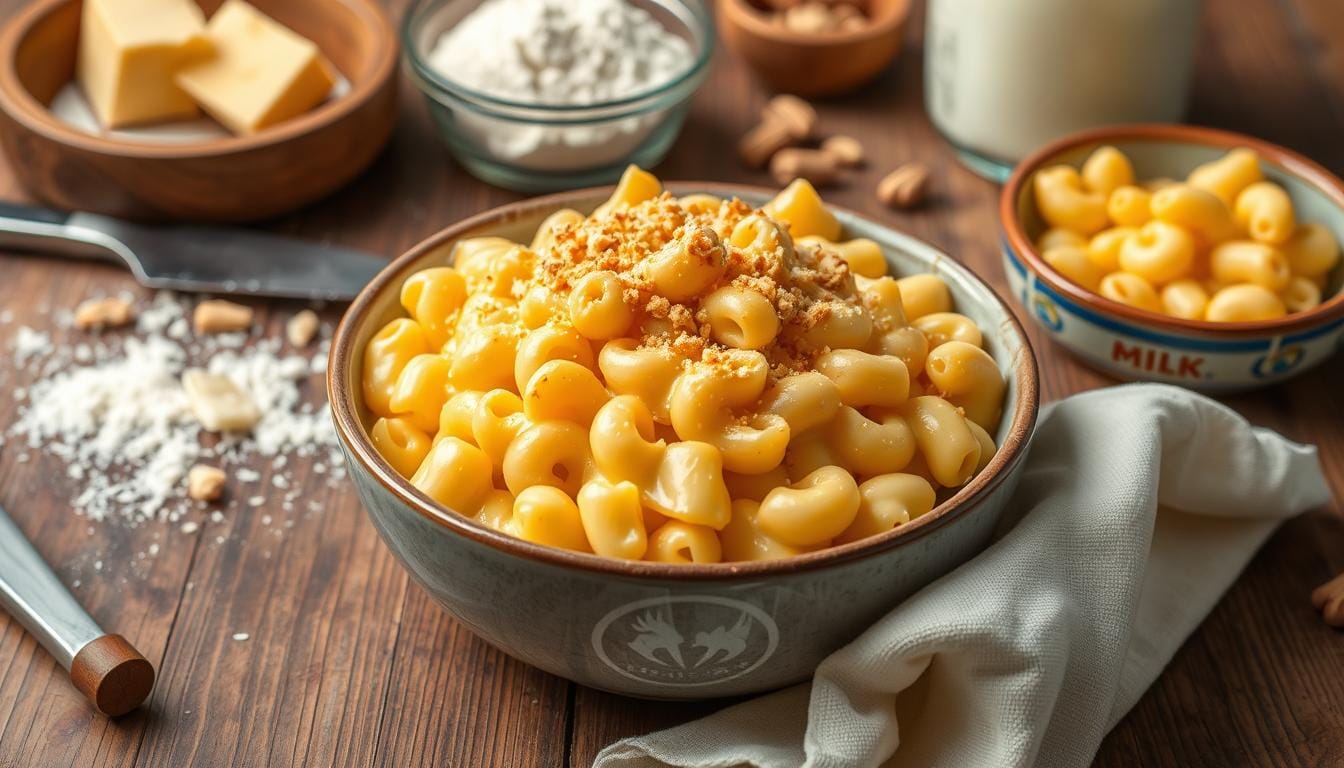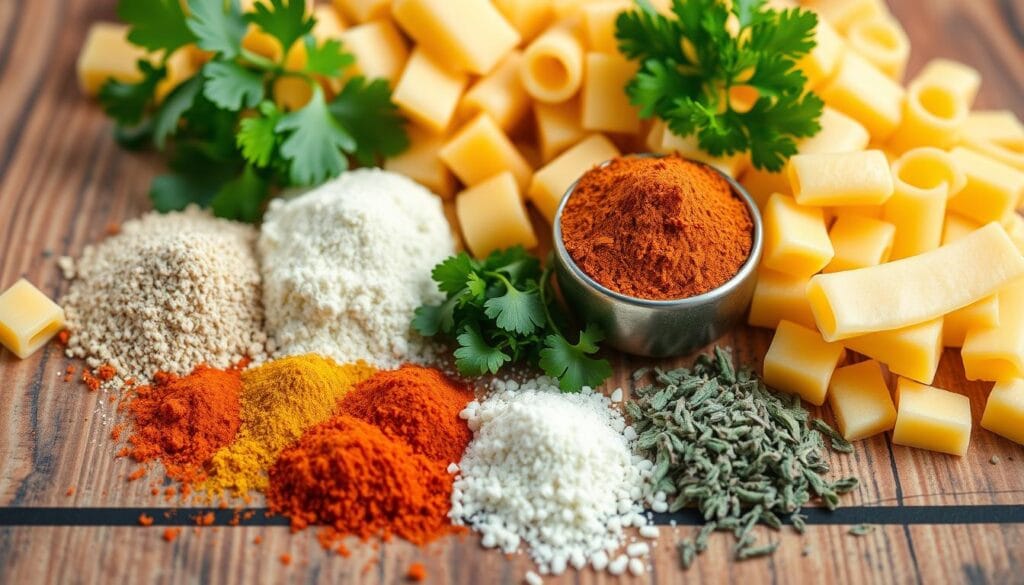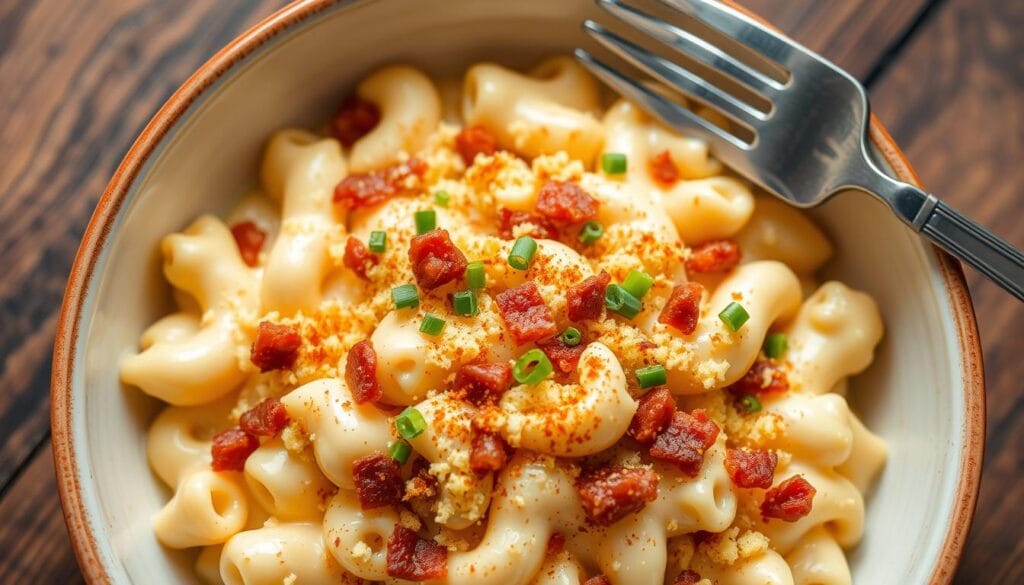Looking at a steaming bowl of mac and cheese brings back happy memories. It reminds me of my childhood, filled with warmth and comfort. The smell of melted cheddar and the soft pasta take me back to cozy family times.
Mac and cheese is more than just a meal; it’s a heartwarming experience. It can be a classic recipe or a modern twist, but it always brings people together. Ever wondered what makes the perfect mac and cheese?
In this guide, we’ll explore the key ingredients for mac and cheese. We’ll cover the best pasta and the creamiest cheese blends. Get ready to make your mac and cheese even better and impress everyone with your skills.
Introduction to Mac and Cheese
Mac and cheese is a comfort food loved by many in America. It has a long history, changing from simple to gourmet. You can make it baked or on the stovetop, adding your own twist.
Brief History of Mac and Cheese
The story of mac and cheese starts in the 14th century Italy. It came to the U.S. in the late 1700s. Since then, it has grown, with each place adding its own touch.
Popular Variations Across the U.S.
- Baked mac and cheese: A American dish loved for its creamy sauce and crispy top.
- Stovetop mac and cheese: Quick and easy, with a mix of cheeses for flavor.
- Regional specialties: Places like the Northeast and Southwest have their own mac and cheese, showing local tastes.
“Mac and cheese is the ultimate comfort food, and it’s amazing how many different ways you can make it.”
Essential Base Ingredients for Mac and Cheese
Creating the perfect mac and cheese starts with the pasta and cheese. Elbow macaroni is the classic choice. But, other pasta shapes can also make a delicious and pretty mac and cheese.
Types of Pasta to Use
- Elbow macaroni: The classic choice, offering a perfect bite-sized shape to hold the creamy cheese sauce.
- Cavatappi: These corkscrew-shaped noodles provide excellent texture and surface area to capture the cheese.
- Penne: The ridged surface of penne pasta helps the sauce cling to each piece for maximum flavor.
- Farfalle (bow-tie): The unique shape of farfalle adds visual interest and a fun presentation to your mac and cheese.
Best Types of Cheese for Creaminess
Sharp cheddar is the top pick for its bold flavor and meltiness. Mixing cheddar with other cheeses can make your mac and cheese even creamier and more complex.
- Cheddar: Sharp cheddar is the backbone of many mac and cheese recipes, providing a strong, satisfying cheese flavor.
- Gruyère: This Swiss cheese adds a nutty, earthy note and contributes to the creamy texture.
- Fontina: Fontina’s mild, buttery flavor and excellent melting properties make it a fantastic addition to the cheese blend.
- Monterey Jack: Monterey Jack cheese brings a subtle sweetness and creamy consistency to the mix.
For the best results, grate the cheese fresh from a block. This way, the cheese will melt smoothly into the sauce, making it creamy and luxurious.
Dairy Ingredients for Richness
Choosing the right dairy ingredients is key to a rich mac and cheese. Whole milk and half and half are top picks for their creamy texture and flavor.
Milk or Cream: Which to Choose?
Whole milk is a favorite for mac and cheese. It adds a creamy richness. The fat in whole milk makes the sauce silky and velvety, covering each noodle well.
Half and half, a mix of whole milk and cream, also offers a rich taste. It’s a great choice for a creamy mac and cheese.
Alternatives for Lactose Intolerance
- For those who can’t digest lactose, plant-based milks like almond, soy, or oat milk are good substitutes.
- Remember, these alternatives might change the dish’s texture and taste. They have less fat than whole milk or cream.
- Try different plant-based milks to find the one you like best and fits your diet.
The choice of dairy in your mac and cheese depends on your taste and diet. Knowing about whole milk, half and half, and dairy alternatives helps you make a dish that’s just right for you.
Seasonings and Enhancements
Mac and cheese is more than just pasta and cheese. The right seasonings and enhancements can make it truly special. From must-have spices to optional flavor boosters, the right mix can add depth and a gourmet touch.
Must-Have Seasonings
Every mac and cheese needs a few key seasonings. Salt and black pepper are a must, providing the basic taste. Dry mustard adds a subtle tanginess, balancing the cheese sauce’s richness.
Optional Flavor Boosters
After the basics, you can add more seasonings to elevate your mac and cheese. Paprika and cayenne pepper add smoky warmth and a bit of spice. Garlic powder or minced garlic add savory, aromatic flavors. Ground thyme brings an earthy, herbaceous note.
Start with the essential seasonings and then add more to taste. With a bit of experimentation, you can turn simple mac and cheese into a gourmet dish.
Adding Proteins to Your Mac and Cheese
Make your mac and cheese more filling by adding proteins. You can choose from animal or plant-based options. This way, you can make your cheesy dish more nutritious.
Popular Proteins to Include
- Bacon bits: Crispy bacon adds a savory, salty crunch that pairs perfectly with the creamy cheese sauce.
- Diced chicken: Cooked chicken breast or thighs can turn your mac and cheese into a complete, protein-packed entrée.
- Tuna: Canned tuna is an easy way to incorporate extra protein, especially if you’re looking for a quick and convenient option.
Vegetarian Protein Options
- Tofu: Firm or extra-firm tofu can be cubed and added to the mac and cheese for a plant-based protein boost.
- Beans: Kidney, black, or chickpeas lend both protein and fiber to your mac and cheese.
- Plant-based meat substitutes: Crumbled veggie or soy-based “ground meat” can mimic the texture of ground beef or sausage.
Adding these protein-rich ingredients makes your mac and cheese more filling and nutritious. Try different combinations to find the perfect mix of creamy cheese and protein.
| Ingredient | Protein (g) |
|---|---|
| Barilla Protein Plus Elbow Pasta (12 oz) | 17 |
| Cottage Cheese (1 cup) | 28 |
| Cheddar Cheese (1 1/2 cups) | 14 |
| Protein Powder (1/2 cup) | 25 |
| Total Protein per Serving | 32 |
Arman Liew created a high-protein mac and cheese recipe. It has over 30 grams of protein per serving. This dish uses protein-rich pasta, cottage cheese, and optional protein powder for a nutritious meal.
Veggies to Make It Healthier
Adding veggies to your mac and cheese can make it healthier. Try using broccoli, peas, cauliflower, and spinach. These veggies add fiber, vitamins, and color to your dish.
Common Vegetables to Add
- Broccoli: Cut broccoli into small pieces and steam or sauté them before adding to your mac and cheese.
- Peas: Use frozen peas. Add them in the last few minutes of cooking to keep them green and tender.
- Cauliflower: You’ll need half a small cauliflower, about 400g. Roast or sauté it before mixing it in.
- Spinach: Add fresh spinach leaves to the hot mac and cheese for a nutrient boost.
Tips for Cooking Veggies
Cook veggies separately and add them just before serving. This keeps their texture and color. Steaming or sautéing briefly is best to avoid overcooking.
| Vegetable | Amount Used | Preparation |
|---|---|---|
| Cauliflower | 400g | Roasted or sautéed |
| Zucchini | 250g | Sautéed |
| Grated Cheese | 125g | Added to cheese sauce |
| Uncooked Pasta | 250g | Cooked according to package instructions |
| Milk | 250ml | Heated for cheese sauce |
| Butter/Oil | 30g | Used in cheese sauce |
| Flour | 30g | Incorporated into cheese sauce |
| Bacon (optional) | 2 rashers | Cooked and crumbled |
Adding broccoli, peas, cauliflower, and spinach to your mac and cheese makes it healthier. These veggies boost the dish’s fiber and vitamins. They also add color and texture.
Cooking Method and Techniques
There are two main ways to make perfect mac and cheese: stovetop or baked. Each method has its own benefits and things to consider. Let’s look at each method to help you get that creamy, cheesy taste you love.
Stovetop vs. Baked Mac and Cheese
The stovetop method starts with making a roux. You melt butter and mix in flour to make a thick paste. Then, you add milk or cream and shredded cheese, like sharp cheddar. After the sauce is smooth, you mix it with al dente pasta for a classic mac and cheese.
The baked version also starts with a cheese sauce. But then, you put the mac and cheese in a baking dish and bake it. This makes the mac and cheese heartier and more casserole-like.
Tips for Perfect Consistency
- Slightly undercook the pasta to avoid it becoming mushy when baked.
- Avoid overheating the cheese sauce, as this can cause the cheese to become grainy or separated.
- Shred the cheese using a box grater or food processor for the best melting performance.
- Add the cheese to the sauce little by little, allowing each batch to melt completely before adding more.
- Consider using a combination of cheeses, such as cheddar and Gruyère, for a more complex flavor profile.
Whether you choose stovetop or baked, the secret to perfect mac and cheese is in the balance. With practice, you’ll soon be making creamy, cheesy dishes like a pro.
Toppings for Extra Flavor and Crunch
Make your mac and cheese even better with a tasty topping. Try breadcrumbs, extra cheese, and crispy onions for a crunchy texture and rich flavor. These toppings can turn your mac and cheese into a standout dish.
Classic Topping Ideas
- Buttery Breadcrumbs: Mix panko or coarse dry breadcrumbs with melted butter for a crispy, golden topping.
- Extra Cheese: Sprinkle on more shredded cheddar, Parmesan, or a mix of cheeses for an extra cheesy bite.
- Crispy Onions: Fry up thinly sliced onions until golden and crunchy, then scatter them over the mac and cheese.
Unique Topping Suggestions
- Crushed Crackers: Crush up butter crackers, Saltines, or oyster crackers to add a delightful crunch.
- Toasted Nuts: Sprinkle on toasted and chopped pecans, walnuts, or almonds for a nutty flavor contrast.
- Herb-Infused Breadcrumbs: Mix breadcrumbs with fresh herbs like parsley, thyme, or rosemary for an herbal twist.
Choosing the right topping can make a big difference. It adds texture and flavor to the creamy mac and cheese. Try different toppings to find your favorite mac and cheese.
Storing and Reheating Leftovers
Keeping your mac and cheese fresh and tasty is key. Even after a few days, it can still be delicious. Just follow a few easy steps to enjoy your leftovers fully.
Best Practices for Storage
Store your mac and cheese in an airtight container in the refrigerator for up to 3 days. This keeps it creamy and prevents the sauce from drying out. If you have a lot, divide it into smaller containers to cool faster and more evenly.
For longer storage, freeze it for 2-3 months. Use a freezer-safe, airtight container or wrap it tightly in plastic or foil. This stops freezer burn and keeps the taste and texture good.
How to Reheat for Best Results
There are a few ways to reheat your mac and cheese:
- Microwave: Add a splash of milk before microwave reheating. This makes the sauce creamy again. Heat in 30-second bursts, stirring often, until it’s hot all over.
- Oven: Preheat to 350°F (177°C). Put the mac and cheese in an oven-safe dish, cover with foil, and bake for 15-20 minutes, or until it’s hot.
- Stovetop: Heat it in a saucepan over medium heat, stirring often. Add a splash of milk if the sauce gets too thick.
Watch your leftovers closely to avoid overcooking. This can make the sauce separate and become grainy.
“Properly storing and reheating your mac and cheese leftovers ensures you can enjoy every bite to the fullest, even days later.”
Conclusion: Tailoring Your Mac and Cheese
Mac and cheese is incredibly versatile. You can make it your own by trying new things. Mix different cheeses, add spices, or use unique ingredients. This way, you can create your perfect mac and cheese.
Personalizing Your Recipe
Begin by trying out various cheeses. You can mix classic cheddar with Gouda, Parmesan, or blue cheese. This creates a rich taste that excites your senses. Feel free to add things like jalapeños, sun-dried tomatoes, or honey for a unique twist.
Experimenting with New Ingredients
Homemade mac and cheese lets you add your favorite things. Try adding bacon, ham, or pulled beef for extra flavor. For a healthier option, add veggies like broccoli, spinach, or bell peppers. The goal is to find the right mix of flavors and textures that you love.
FAQ
What ingredients do I need for mac and cheese?
You’ll need elbow macaroni, butter, flour, salt, and pepper. Also, whole milk, half and half, and shredded cheddar cheese. Aged cheddar tastes better and melts smoothly. You can also add dry mustard, eggs, and seasonings for extra flavor.
What are the popular variations of mac and cheese?
Mac and cheese has grown from simple to gourmet. You can try baked, stovetop, or regional versions. Each uses unique ingredients and cooking methods.
What type of pasta and cheese are best for mac and cheese?
Elbow macaroni is classic, but other shapes work too. For cheese, sharp cheddar is great. Mixing Colby, Monterey Jack, fontina, or Gruyère adds flavor and creaminess. Grate your cheese fresh for the best melt.
What dairy ingredients should I use for the perfect mac and cheese sauce?
Use whole milk and half and half for a creamy sauce. Whole milk is key for creaminess. If you’re lactose-intolerant, plant-based milks can work, but they might change the dish’s texture and taste.
What seasonings are essential for mac and cheese?
Salt, black pepper, and dry mustard are must-haves. You can also add paprika, cayenne pepper, garlic powder, or thyme. Dry mustard adds a tangy touch without overpowering the cheese.
What protein and vegetable additions can I make to mac and cheese?
Add bacon bits, diced chicken, or tuna for protein. For veggies, try broccoli, peas, cauliflower, or spinach. Steam or sauté them before mixing with the mac and cheese.
What are the differences between stovetop and baked mac and cheese?
Stovetop makes a roux, then adds milk and cheese for sauce. Mix with pasta. Baked mac assembles in a dish and bakes. Cook pasta slightly under and avoid hot cheese sauce.
What are some classic and unique topping ideas for mac and cheese?
Try breadcrumbs, extra cheese, or crispy onions on top. For something different, use crushed crackers, toasted nuts, or herb breadcrumbs. These add texture and flavor.
How should I store and reheat leftover mac and cheese?
Keep leftovers in an airtight container in the fridge for 3 days. Reheat with a bit of milk, either in the microwave or oven. Avoid overheating to keep the sauce together.



